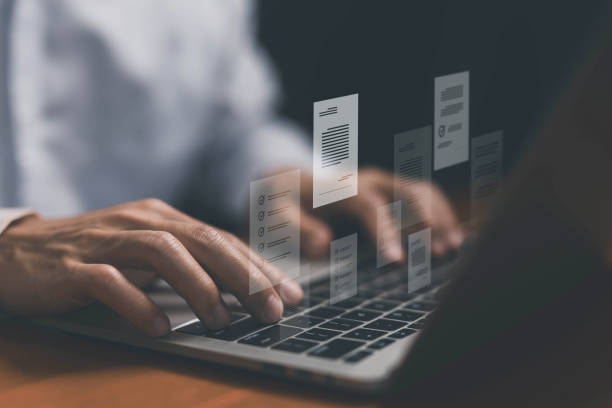### What is On-Page SEO and Why is it Important?
[Image: 3D word big data with magnifying glass]
**On-Page SEO**, also known as On-Page SEO, refers to the set of actions you take within your website to improve its ranking in the search results of Google and other search engines.
These actions include optimizing content, site structure, HTML tags, and other technical factors that help search engines better understand your site’s content and show it to relevant users.
The importance of #On_Page_SEO lies in the fact that it directly affects the visibility of your website.
A site that is well-optimized for on-page SEO is more likely to rank high in search results and, as a result, attract more traffic.
This traffic can lead to increased sales, increased brand awareness, and the achievement of your business goals.
In other words, **On-Page SEO** provides a solid foundation for success in the online world.
In fact, by making the necessary optimizations on your site, you are telling search engines that your site is authoritative, relevant, and valuable.
Optimizing Technical SEO is also very important for better site performance.
In addition, we should not overlook the impact of site speed. To increase your site speed, you should analyze your site with gtmetrix and fix the site’s speed problems.
> Does your current company website present a worthy image of your brand and attract new customers?
>
> If not, turn this challenge into an opportunity with Rasaweb’s professional corporate website design services.
>
> ✅ Significantly improves your brand’s credibility and image.
>
> ✅ Paves the way for attracting leads and new customers.
>
> ⚡ Contact Rasaweb now for free and expert consultation!
### Keyword Research and Choosing the Best Ones
[Image: Big data with optical glass]
Keyword Research is one of the most important steps in **On-Page SEO**.
The purpose of this is to identify the words that users use to search for products, services, or information they need in search engines.
By identifying these words, you can optimize your site’s content based on them to increase your chances of being seen in search results.
To start keyword research, you can use various tools such as Ahrefs, Moz Keyword Explorer, Ubersuggest, and Google Keyword Planner.
These tools help you find keywords related to your field of activity, check their search volume, and identify competitor keywords.
When choosing keywords, pay attention to a few important points.
First, the keywords must be relevant to your site’s content.
Second, the keywords should have a suitable search volume.
Third, the keywords should have less competition.
Choosing the right keywords will have a significant impact on the success of your **On-Page SEO** strategy.
Click here to preview your posts with PRO themes ››
### Optimizing Content for SEO and Users
[Image: Businessman using a computer with SEO search engine optimization]
Content optimization is one of the main pillars of **On-Page SEO**.
Your content should be both attractive and useful to search engines and users.
For this purpose, you should use your target keywords in the title, meta descriptions, body text, and H2 and H3 tags.
However, you should avoid excessive use of keywords (Keyword Stuffing), as this can negatively impact your site’s ranking.
In addition, your content should be high-quality, unique, and valuable.
Try to create content that answers users’ questions, solves their problems, and provides useful information.
Also, update your content regularly so that search engines know that your site is active and dynamic.
Using images, videos, and infographics can also help to make your content more attractive and user-friendly.
Remember that the ultimate goal of content optimization is to provide the best user experience for your site visitors.
A strong content strategy and its precise implementation can make a big difference in the success of your **On-Page SEO**.
“`html
“`
“`html
| Element | Description |
|---|---|
| Page Title | Use the main keyword |
| Meta Description | Provide an attractive summary of the content |
| H2 and H3 Tags | For structuring content and using secondary keywords |
“`
### Optimizing Titles and Meta Descriptions
[Image: Black calculator and magnifying glass GST text beautiful yel]
Titles and Meta Descriptions are among the most important elements of **On-Page SEO**.
The page title is the text that appears in the browser tab and in search results.
The title should be attractive, relevant, and include the main keyword.
The title length should not exceed 60 characters to be fully displayed in search results.
The meta description is a summary of the page’s content that appears below the title in search results.
The meta description should be attractive, concise, and include secondary keywords.
The length of the meta description should not exceed 160 characters.
Titles and meta descriptions are the first things that users see in search results.
Therefore, optimizing them can have a significant impact on your site’s click-through rate (CTR).
The higher your click-through rate, the more likely your site is to rank higher in search results.
Optimizing titles and meta descriptions is a simple but effective way to improve your site’s **On-Page SEO**.
> Is your online sales not as expected? With Rasaweb, solve the problem of low sales and poor user experience forever!
>
> ✅ Increase the conversion rate of visitors to customers
>
> ✅ Create a pleasant user experience and increase customer trust
>
> ⚡ Act now to receive free consultation!
### URL Structure and Internal Linking
[Image: Woman using laptop with VR SEO text interface]
URL structure and internal linking are two important factors in **On-Page SEO**.
The URL structure should be simple, clear, and include keywords.
Avoid using long and complex URLs.
URLs should be designed so that users and search engines can easily understand the content of the page.
Internal linking means creating links between different pages of your site.
Internal linking helps search engines better understand your site structure and identify more important pages.
Also, internal linking helps users easily navigate your site and find the content they are looking for.
When internal linking, pay attention to a few important points.
First, the links must be relevant to the content of the destination page.
Second, use descriptive Anchor Text.
Third, avoid excessive linking.
A suitable internal linking strategy can help improve your site’s ranking in search results and improve the user experience.
**On-Page SEO** with optimized internal linking can make your site more understandable for search engines.
### Optimizing Images and Videos
[Image: Magnifying glass over SEO word]
Optimizing images and videos is another important aspect of **On-Page SEO**.
Images and videos can help to make your content more attractive and user-friendly, but if they are not properly optimized, they can negatively impact your site’s speed and reduce your site’s ranking in search results.
To optimize images, use appropriate formats such as JPEG or PNG, reduce the image size, and use Alt tags to describe the images.
The Alt tag helps search engines understand the content of the images and show them to relevant users.
To optimize videos, use appropriate platforms such as YouTube or Vimeo, choose appropriate titles and descriptions for the videos, and use appropriate tags.
You can also use Schema Markup to provide more information about images and videos to search engines.
Optimizing images and videos is an effective way to improve your site’s **On-Page SEO** and provide the best user experience for your site visitors.
In fact, by optimizing multimedia, you can help both search engines and users to better understand and enjoy your content.
### Optimizing Site Speed
[Image: 4Ps text on magnifier on a keyboard business concept]
Site speed is an important factor in **On-Page SEO** and user experience.
Faster sites provide a better user experience and are more likely to keep users on your site and using your content.
Search engines also prefer faster sites and rank them higher in search results.
To optimize site speed, you can use various solutions such as optimizing images, using CDN, enabling Gzip compression, using browser caching, and reducing the number of HTTP requests.
You can also use tools such as Google PageSpeed Insights and GTmetrix to identify the speed problems of your site and find suitable solutions to fix them.
Optimizing site speed is a valuable investment that can have a significant impact on the success of your **On-Page SEO** and improve the user experience.
High site speed has a direct impact on improving SEO.
“`html
“`
“`html
| Technique | Description |
|---|---|
| Image Optimization | Reducing image size without loss of quality |
| Using CDN | Using content delivery networks to speed up loading |
| Enabling Gzip compression | Compressing files for faster transfer |
“`
### Optimizing Mobile-Friendliness
[Image: 3D word big data with magnifying glass]
Given the increasing use of mobile devices to access the internet, optimizing the Mobile-Friendliness of your site has become particularly important.
Mobile-friendly sites are easily viewable and usable on mobile devices.
Search engines also prefer mobile-friendly sites and rank them higher in search results for mobile users.
To optimize the mobile-friendliness of your site, you should use responsive design, improve your site’s speed on mobile devices, and use fonts and buttons that are appropriate for mobile devices.
You can also use the Google Mobile-Friendly Test tool to check the mobile-friendliness of your site and identify potential problems.
Optimizing mobile-friendliness is a necessity for success in today’s online world and can have a significant impact on your **On-Page SEO** and improve the user experience.
If your site is not optimized for mobile, you will miss many opportunities.
> Are you worried about the low conversion rate of your online store and not having the sales you want?
>
> Rasaweb is your specialized solution for having a successful online store.
>
> ✅ Significantly increase conversion rate and sales
>
> ✅ Professional and user-friendly design to attract customer satisfaction
>
> ⚡ Ready for a transformation in online sales? Get a free consultation!
### Using Schema Markup
[Image: Economies of scale cost advantages that enterprises obtain d]
Schema Markup is an HTML code that allows you to provide more information about your page content to search engines.
By using schema markup, you can tell search engines what your page is about, what type of content it has, and what important information it provides.
Search engines can use this information to display richer search results (Rich Snippets), which can increase your site’s click-through rate (CTR).
There are different types of schema markup that you can use for different pages of your site, including schema for articles, products, events, restaurants, and people.
To use schema markup, you can use tools like Schema Markup Generator and add the corresponding HTML code to your pages.
Using schema markup is an effective way to improve your site’s **On-Page SEO** and increase visibility in search results.
By using this technique, you can help search engines better understand your content and show it to relevant users.
### Measuring and Analyzing On-Page SEO Results
[Image: Digital online marketing businessman using tablet and analyz]
Measuring and analyzing **On-Page SEO** results is an essential step to ensure the effectiveness of your strategy.
By measuring and analyzing the results, you can identify the strengths and weaknesses of your strategy and make the necessary changes to improve your site’s performance.
To measure and analyze **On-Page SEO** results, you can use various tools such as Google Analytics and Google Search Console.
Google Analytics gives you information about site traffic, user behavior, and conversion rates.
Google Search Console gives you information about site performance in search results, the keywords that users use to find your site, and technical problems of the site.
By using this information, you can make more informed decisions about your **On-Page SEO** strategy and continuously improve your site’s performance.
Remember that **On-Page SEO** is an ongoing process and requires patience, effort, and follow-up.
By measuring and analyzing the results, you can get the best results from your investment in **On-Page SEO**.
#### Frequently Asked Questions
“`html
| Number | Question | Answer |
|---|---|---|
| 1 | What is On-Page SEO? | On-Page SEO refers to the set of actions that are performed within the website and to optimize its pages in order to gain a better ranking in search results. |
| 2 | What is the most important factor in On-Page SEO? | High-quality, relevant, and comprehensive content that meets the user’s needs is the most important factor in On-Page SEO. |
| 3 | What role does the Title Tag play in On-Page SEO? | The Title Tag is one of the most important factors that tells search engines and users what the page’s content is about. It should include the main keyword and be attractive. |
| 4 | How important is the Meta Description tag? | Although it does not directly affect ranking, it is very effective on the click-through rate (CTR) in search results and encourages users to visit the page. |
| 5 | How is image optimization done in On-Page SEO? | By using the appropriate alt tag, compressing the image size to increase loading speed, and meaningful naming of the image file. |
| 6 | What is the importance of using Headings (H1, H2, H3) in On-Page SEO? | Headings help structure content, increase readability, and help search engines understand the hierarchy and sub-topics of content. |
| 7 | What does Internal Linking mean and what are its benefits? | Internal linking means creating links between different pages of a website. This helps to distribute authority, improve user navigation, and help search engine crawling. |
| 8 | Where should the Focus Keyword be placed on the page? | The main keyword should be in the Title Tag, Meta Description, H1, first paragraph, and naturally throughout the text and, if possible, in the URL address. |
| 9 | What effect does duplicate or copied content have on On-Page SEO? | Duplicate content can damage the site’s ranking and confuse search engines as to which version is the original, and may identify it as spam. |
| 10 | How important is the page loading speed in On-Page SEO? | Page loading speed is an important ranking factor and directly affects user experience. Slow pages increase the bounce rate of users. |
“`
**And other services of Rasa Web Advertising Agency in the field of advertising**
Intelligent Digital Advertising: Professional optimization for user interaction using attractive user interface design.
Intelligent Reportage: A combination of creativity and technology for digital branding through intelligent data analysis.
Intelligent Conversion Rate Optimization: A new service to increase click-through rates through Google Ads management.
Intelligent Advertising Campaign: A new service to increase click-through rates through SEO-oriented content strategy.
Intelligent Digital Branding: A combination of creativity and technology for online growth through attractive user interface design.
And more than a hundred other services in the field of internet advertising, advertising consulting, and organizational solutions
Internet Advertising | Advertising Strategy | Reportage Advertisement
#### Resources
[https://www.zepo.ir/blog/website-seo/](https://www.zepo.ir/blog/website-seo/) Website SEO Optimization: 33 Tips to Improve Site Ranking
,[https://farazseo.com/blog/what-is-on-page-seo/](https://farazseo.com/blog/what-is-on-page-seo/) What is On-Page SEO? + 10 Golden Techniques to Improve Site On-Page SEO
,[https://seokar.ir/on-page-seo/](https://seokar.ir/on-page-seo/) What is On-Page SEO? Comprehensive Training of On-Page Site Optimization
,[https://www.aparat.com/v/eJt3M/%D8%A2%D9%85%D9%88%D8%B2%D8%B4_%D8%B3%D8%A6%D9%88_%D8%AF%D8%A7%D8%AE%D9%84%DB%8C_%D8%B3%D8%A7%DB%8C%D8%AA%D8%9B_%D8%B3%D8%A6%D9%88_%D8%A2%D9%86_%D9%BE%DB%8C%D8%AC_%28On-Page_SEO%29_%D8%AA%D8%B5%D9%88%DB%8C%D8%B1%DB%8C_%D9%88_%DA%A9%D8%A7%D8%B1%D8%A8%D8%B1%D8%AF%DB%8C_%D8%A7%D8%B3%D8%AA%D8%B1%D8%A7%D8%AA%DA%98%DB%8C%E2%80%8C%D9%87%D8%A7%DB%8C](https://www.aparat.com/v/eJt3M/%D8%A2%D9%85%D9%88%D8%B2%D8%B4_%D8%B3%D8%A6%D9%88_%D8%AF%D8%A7%D8%AE%D9%84%DB%8C_%D8%B3%D8%A7%DB%8C%D8%AA%D8%9B_%D8%B3%D8%A6%D9%88_%D8%A2%D9%86_%D9%BE%DB%8C%D8%AC_%28On-Page_SEO%29_%D8%AA%D8%B5%D9%88%DB%8C%D8%B1%DB%8C_%D9%88_%DA%A9%D8%A7%D8%B1%D8%A8%D8%B1%D8%AF%DB%8C_%D8%A7%D8%B3%D8%AA%D8%B1%D8%A7%D8%AA%DA%98%DB%8C%E2%80%8C%D9%87%D8%A7%DB%8C) On-Page Site SEO Training; Visual and Applied Strategies On-Page SEO
Are you ready to transform your business in the digital world? Rasa Web Digital Marketing Agency, specializing in providing comprehensive digital solutions, from corporate website design to SEO optimization and social media management, is ready to help you on the path to growth and achieving your goals. With us, have a powerful and influential presence in the online space.
📍 Tehran, Mirdamad Street, next to the Central Bank, Southern Kazerun Alley, Ramin Alley No. 6
✉️ [info@idiads.com](mailto:info@idiads.com)
📱 [09124438174](tel:+989124438174)
📱 [09390858526](tel:+989390858526)
📞 [02126406207](tel:+982126406207)





